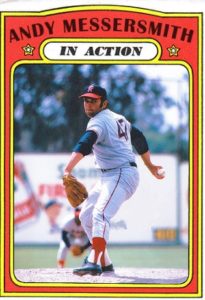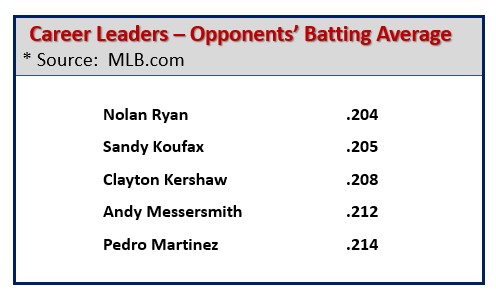BASEBALL ROUNDTABLE TRIVIA TEASER
Fill in the blank:
—–Career-Low Opponents’ Batting Average (MLB.com listing)—–
Nolan Ryan .204
Sandy Koufax .205
Clayton Kershaw .208
_______________ .212
Pedro Martinez .214
Hint: I initially came up with this in the a.m. hours.
Baseball Roundtable Trivia Teaser Answer
The answer is Andy Messersmith (initials A.M. per the hint), who pitched to a .212 opponents’ batting average over twelve MLB seasons (2,230 1/3 innings pitched) for the Angels (1968-72), Dodgers (1973-75 & 1979), Braves (1976-77) and Yankees (1978).
Messersmith, a 6’1”, 200-pound righthander made it to the majors In July of 1968 (at age 22). He went on to become a four-time All Star, two-time 20-game winner and two-time Gold Glover. He did all of this with a fastball with movement, hard overhand curve, solid slider and effective change up. His final career stat line was 130-99, with a 2.86 earned run average and 1,625 strikeouts. He led his league one season each in wins, games started, complete games, shutouts and innings pitched. He also gave up his league’s fewest hits per nine innings (among qualifiers) in three seasons.
Reserve Clause
Andy Messersmith is also noted for his role in successfully challenging (along with Dave McNally) MLB’s reserve clause, which led to the 1975 ruling by arbitrator Peter Seitz that player who played one year for their teams without a signed contract could become free agents at the end of that year (basically ending the acceptance of unilateral contract renewals as a way to “reserve” a player).
 Messersmith’s best year was arguably 1975, when he went 19-14, with a 2.29 ERA (for the Dodgers) and led the NL in starts (40), complete games (19), shutouts (7) and innings pitched (321 2/3); while also earning a Gold Glove. This followed a 1974 season during which he went 20-6, 2.59 and was the NL All Star Game starter.
Messersmith’s best year was arguably 1975, when he went 19-14, with a 2.29 ERA (for the Dodgers) and led the NL in starts (40), complete games (19), shutouts (7) and innings pitched (321 2/3); while also earning a Gold Glove. This followed a 1974 season during which he went 20-6, 2.59 and was the NL All Star Game starter.
For those not familiar with Messersmith’s history, he was a high school quarterback and pitcher (going 16-2 in his senior season), before receiving a full scholarship (baseball) to the University of California Berkeley (1963), where he earned All-NCAA District and second-team All American honors. He was a first-round draft choice (12th overall) of the Angels in June of 1966 and was in the majors (with the Angels) by 1968 (when he went 4-2, 2.21 primarily as a reliever). In 1969, he earned a spot in the Angels’ starting rotation (16-11, 2.52) and the rest is history. His career totals were diminished by a number of injuries: 1970 (ribs); 1972 (finger injury/surgery); 1977 (elbow/surgery); 1978 (shoulder). When he was healthy, however, he was one of the best. Notably, Messersmith threw over 200 innings in six seasons, had an earned run average under 3.00 in seven campaigns and had at least ten complete game seven times.
Just Watch Me.
For about a month-and-a half of the 1976 season, Ted Turner’s Atlanta Braves – perhaps foreshadowing the current MLB Players’ Weekend – wore nicknames above the numbers on their home jerseys. For example, Biff Pocoroba wore “Poco” on his back, Dick Ruthven wore “Rufus”), Phil Niekro wore “Knucksie” and Jimmy Wynn wore “Cannon.”
The most interesting of these may have been Any Messersmith – a newcomer to the Braves that season – who (in an apparent publicity move) wore the nickname (which he had never used) “Channel” above his number 17. (Channel 17 was where you would find Turner’s cable TV “Superstation WTCG.”) In a bit of Irony, NL President Charles Feeney (much better known by the nickname”Chub”) objected to this rather obvious bit of promotion and put an end to it, with Messersmith moving on “Bluto,” a nickname he had acquired while with the Dodgers. Braves’ PR Director at the time, Bob Hope (No, not that Bob Hope) later said the nickname served its purpose, “We knew baseball would step in and stop it, but we would get lots of publicity.”
Sources: Baseball-Refeence.com; MLB.com; “Uni Watch’s Friday Flashback: What in a nickname” by Paul Lucas fort ESPN.com, May 13, 2016; Andy Messersmith Society for American Baseball Research bio, by Eric Golanty.
 Baseball Roundtable is on the Feedspot list of the Top 100 Baseball Blogs. To see the full list, click here.
Baseball Roundtable is on the Feedspot list of the Top 100 Baseball Blogs. To see the full list, click here.
I tweet baseball @DavidBBRT
Follow/Like Baseball Roundtable’s Facebook Page here. More baseball commentary; blog post notifications; PRIZES.
Member: Society for American Baseball Research (SABR); The Baseball Reliquary; The Negro Leagues Baseball Museum.







